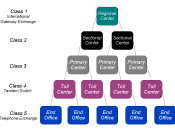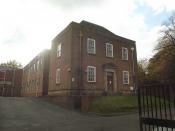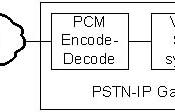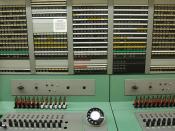PUBLIC SWITCHED TELEPHONE NETWORK The Public Switched Telephone Network (PSTN) is a variety of companies and government agencies that are linked by interconnected data transmission systems. Although the PSTN has changed with time, its functionality has remained constant. The main function of the PSTN is to transmit information, whether it is voice or data. The PSTN is now a part of just about everyone's lives and continues to expand with the popularity and growth of the Internet, cell phones and satellites.
The PSTN has many components including drop wires, terminals, computers, switches, central offices, LEC's, local loops, inside wire, trunk lines and of course the telephone. The components of the PSTN are rapidly changing to increase the speed at which information can be transmitted.
An overview of how the PSTN works, starting from the outside plant. Basically the outside plant consist of several components, poles, conduit, fiber, copper cables that all work in unison to connect the Central Office to the Subscriber (paying customer).
All these components come together to create the Local Loop.
There are five different classes of Central Offices (1-5). Class 5 offices are the local exchange offices. These are the offices that serve the end users. Class 4 offices are tandem toll centers, which serve to interconnect Class 5 offices that are not directly connected. As the lowest class of toll center, these also serve as the first point of entry of the long distance, or toll, network. Class 3 offices, or primary toll centers, are higher-order toll centers, generally serving to connect Class 4 offices for intrastate toll calling. Class 2 offices, or sectional toll centers, serve to interconnect primary toll centers, largely for interstate calling within a geographical region. Class 1 office, or regional toll centers, serve to interconnect sectional toll centers in support of interregional calling.( ) A Central Office (CO) services several areas, which are then broken up to one or more smaller locations. CO's are placed about every 16 miles. Each CO handles roughly 41,000 subscriber lines. Originally "Every subscriber line location in a CO switch is assigned a seven-digit number. The first three digits represent the exchange and identify which CO switch serves that particular telephone. The last four digits identify the individual line number, which is a circuit physically connected from the CO to the subscriber. A CO switch can handle one or more exchanges, and each exchange can handle up to 10,000 subscriber lines, numbered 0000 to 9999". ( ) CO's are connected via Trunk lines. These trunk lines are used to support the calls that need to get from one area to another. There are CO's that do not have enough traffic going between them to have direct Trunk lines they would then use a Tandem office to route calls to the different CO's. A Tandem office is when you have two or more other CO's that are not directly connected, they would use a centralized location that the other offices share so that they are able to forward calls to each other.
"The implementation of SS7 in the PSTN, via CO switches and equipment, offers customers advanced networking services without the need for private network systems and facilities. SS7 is an out-of-band signaling system that provides independent network supervisory, addressing, and alerting functionality. The term out-of-band indicates that the signaling functionality is carried on a separate channel from the voice component, as opposed to in-band signaling which carries the voice and signaling components together in the same channel". ( ) Now I will cover the equipment involved for the Local Loop. There are five main components for the local loop, the CO, the feeder cable, the servicing area box, the distribution cable, and the subscriber. The Aerial cable (which is not always in the air) tends to usually be hanging from telephone poles. Another way is to run the cable underground through conduits; this method on the other hand is probably the safest way of connecting lines because of the hidden aspect of the cables. These methods allow companies to place an enormous amount of cable out of the way of society. The two popular types of cable are called your feeder cable (F1) and aerial cable (F2). The F1 cable is the cable that comes from the CO, which usually is run underground via conduit out to each serving area. The F1 cable can be of different sizes that range from 200 pair all the way up to 900 pair. The Serving Area Interface (SAI or B-BOX) is where the F1 cable resurfaces. At this point, the feeder cable is cross-connected to the distribution cables. The F2 cable is the cable that runs from the B-BOX to the subscriber's location. Every time an F1 and F2 cable meet they will be cross connected at a B-BOX.
The PSTN primarily uses copper twisted pair cable, along with microwave and fiber to transmit data. Since the development of satellite dishes and fiber optic cable the rate at which data and voice is transmitted has grown. For many years in the history of telephone networks, speech between two customers was the only relevant service for the PSTN.
There are many companies involved in the PSTN. This group would include Internet providers or Internet Service Provider (ISP), Local Exchange Carrier (LEC), Inter Exchange Carrier (IXC), and any other company involved with its main focus on transmitting voice or data. AT&T, Sprint, MCI are known as Inter Exchange Carriers (IXC) that are part of the PSTN and are primarily used for long distance services. Your local service providers known as LECs, are companies such as Verizon, SBC, and Bell Atlantic. ISP's would include companies like Earthlink, AOL, Prodigy, and CompuServe.
"The Telecommunications Act of 1996, which became law on February 8, 1996 establishes a procompetitive, deregulatory framework for telecommunications in the U.S. The intent of this law is to rapidly accelerate private sector deployment of advanced telecommunications and information technologies and services to all Americans by opening all telecommunications markets to competition. The result of competition would be more and better services at less cost to consumers"( ) With the Telecom ACT of 1996 it opened the doors for the IXC's, LEC's, and ISP's to provide local and long-distance services. The Public Utility Commission (PUC) keeps track of all of the Telephone companies and regulates the rates. If a local telco wants to provide long-distance service, they will have to petition the PUC for consent. Also, if a long-distance provider wishes to provide local service they must also petition the PUC. ISP's have been getting into the local and long-distance market since the 1996 ACT but they are still governed by what they can offer from the PUC. The PUC looks at each petition to see if the company meets the current set requirements to be allowed to do any services outside the companies base service.
In relation to the Internet, the PSTN actually furnishes much of the Internet's long-distance and local dial-up infrastructure.
The PSTN is facing a lot of problems with the ever-expanding Internet services. The PSTN was primarily created for voice service via a switched network. To reduce some of the traffic they are looking into different technologies such as Integrated Service Digital Network (ISDN), and Digital Subscriber Line (DSL) services. These services would use the telephone company's existing copper telephone lines.



